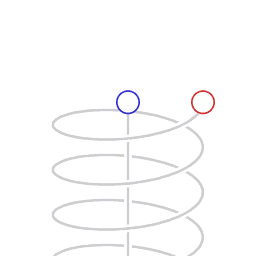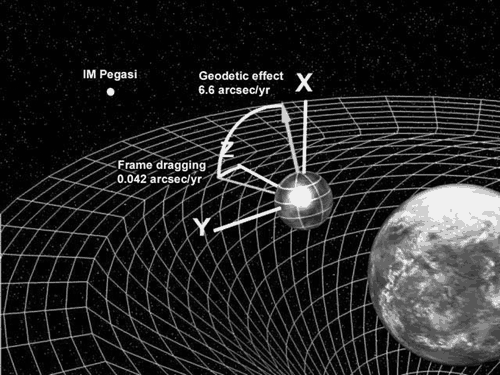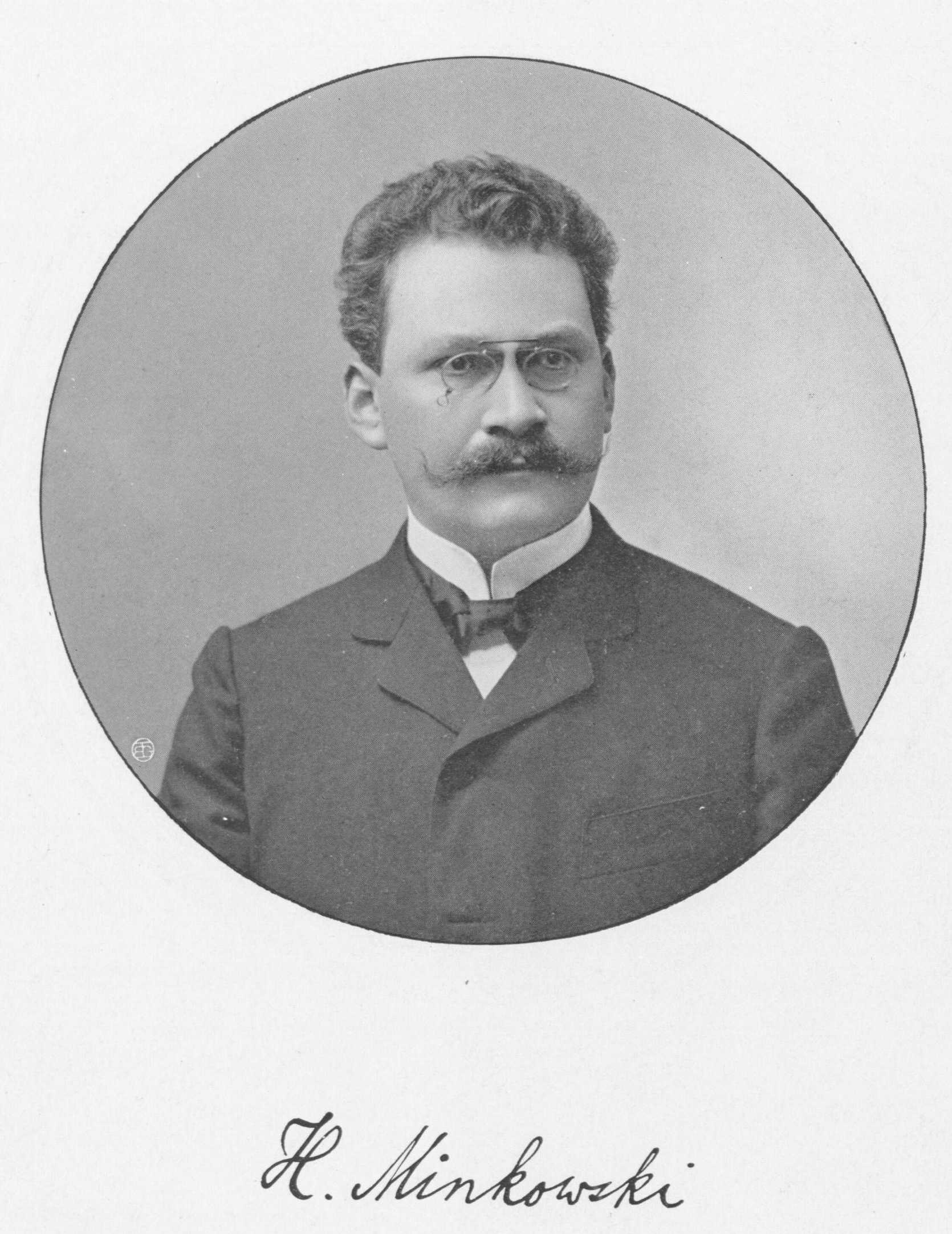|
Thomas Precession
In physics, the Thomas precession, named after Llewellyn Thomas, is a relativistic correction that applies to the spin of an elementary particle or the rotation of a macroscopic gyroscope. It relates the angular velocity of the spin of a particle following a curvilinear orbit to the angular velocity of the orbital motion. For a given inertial frame, if a second frame is Lorentz-boosted relative to it, and a third boosted relative to the second, but non-collinear with the first boost, then the Lorentz transformation between the first and third frames involves a combined boost and rotation, known as the " Wigner rotation" or "Thomas rotation". For accelerated motion, the accelerated frame has an inertial frame at every instant. Two boosts a small time interval (as measured in the lab frame) apart leads to a Wigner rotation after the second boost. In the limit the time interval tends to zero, the accelerated frame will rotate at every instant, so the accelerated frame rotates wi ... [...More Info...] [...Related Items...] OR: [Wikipedia] [Google] [Baidu] |
Relativistic Time Dilation
Time dilation is the difference in elapsed time as measured by two clocks, either because of a relative velocity between them (special relativity), or a difference in gravitational potential between their locations (general relativity). When unspecified, "time dilation" usually refers to the effect due to velocity. The dilation compares "wristwatch" clock readings between events measured in different inertial frames and is not observed by visual comparison of clocks across moving frames. These predictions of the theory of relativity have been repeatedly confirmed by experiment, and they are of practical concern, for instance in the operation of satellite navigation systems such as GPS and Galileo. Invisibility Time dilation is a relationship between clock readings. Visually observed clock readings involve delays due to the propagation speed of light from the clock to the observer. Thus there is no direct way to observe time dilation. As an example of time dilation, two expe ... [...More Info...] [...Related Items...] OR: [Wikipedia] [Google] [Baidu] |
De Sitter
Willem de Sitter (6May 187220November 1934) was a Dutch mathematician, physicist, and astronomer. He is known for the de Sitter universe is a cosmological model, which was named after him. Life and work Born in Sneek, Netherlands, de Sitter studied mathematics at the University of Groningen and then joined the Groningen astronomical laboratory. He worked at the Cape Observatory in South Africa (1897–1899). Then, in 1908, De Sitter was appointed to the chair of astronomy at Leiden University. He was director of the Leiden Observatory from 1919 until his death. De Sitter made major contributions to the field of physical cosmology. In 1916-17. he published a series of papers describing the consequences of Albert Einstein's theory of relativity to the understanding of astronomy, which were directly affected Arthur Eddington's 1919 findings in the famous experiment of the solar eclipse. He co-authored a paper with Einstein in 1932 in which they discussed the implications of co ... [...More Info...] [...Related Items...] OR: [Wikipedia] [Google] [Baidu] |
Ludwik Silberstein
Ludwik Silberstein (May 17, 1872 – January 17, 1948) was a Polish-American physicist who helped make special relativity and general relativity staples of university coursework. His textbook '' The Theory of Relativity'' was published by Macmillan in 1914 with a second edition, expanded to include general relativity, in 1924. Life Silberstein was born on May 17, 1872, in Warsaw to Samuel Silberstein and Emily Steinkalk. He was educated in Kraków, Heidelberg, and Berlin. To teach he went to Bologna, Italy from 1899 to 1904. Then he took a position at Sapienza University of Rome. In 1907 Silberstein described a bivector approach to the fundamental electromagnetic equations. When \mathbf and \mathbf represent electric and magnetic vector fields with values in \mathbb^3, then Silberstein suggested \mathbf + i \mathbf would have values in \mathbb^3, consolidating the field description with complexification. This contribution has been described as a crucial step in modernizing ... [...More Info...] [...Related Items...] OR: [Wikipedia] [Google] [Baidu] |
Dynamics (mechanics)
In physics, dynamics or classical dynamics is the study of forces and their effect on motion. It is a branch of classical mechanics, along with ''statics'' and ''kinematics''. The ''fundamental principle of dynamics'' is linked to Newton's second law. Subdivisions Rigid bodies Fluids Applications Classical dynamics finds many applications: * ''Aerodynamics'', the study of the motion of air * '' Brownian dynamics'', the occurrence of Langevin dynamics in the motion of particles in solution * '' File dynamics'', stochastic motion of particles in a channel * ''Flight dynamics'', the science of aircraft and spacecraft design * ''Molecular dynamics'', the study of motion on the molecular level * '' Langevin dynamics'', a mathematical model for stochastic dynamics * '' Orbital dynamics'', the study of the motion of rockets and spacecraft * '' Stellar dynamics'', a description of the collective motion of stars * '' Vehicle dynamics, the study of vehicles in motion Generalizations ... [...More Info...] [...Related Items...] OR: [Wikipedia] [Google] [Baidu] |
Gravitational Field
In physics, a gravitational field or gravitational acceleration field is a vector field used to explain the influences that a body extends into the space around itself. A gravitational field is used to explain gravitational phenomena, such as the '' gravitational force field'' exerted on another massive body. It has dimension of acceleration (L/T2) and it is measured in units of newtons per kilogram (N/kg) or, equivalently, in meters per second squared (m/s2). In its original concept, gravity was a force between point masses. Following Isaac Newton, Pierre-Simon Laplace attempted to model gravity as some kind of radiation field or fluid, and since the 19th century, explanations for gravity in classical mechanics have usually been taught in terms of a field model, rather than a point attraction. It results from the spatial gradient of the gravitational potential field. In general relativity, rather than two particles attracting each other, the particles distort spa ... [...More Info...] [...Related Items...] OR: [Wikipedia] [Google] [Baidu] |
Electromagnetic Field
An electromagnetic field (also EM field) is a physical field, varying in space and time, that represents the electric and magnetic influences generated by and acting upon electric charges. The field at any point in space and time can be regarded as a combination of an electric field and a magnetic field. Because of the interrelationship between the fields, a disturbance in the electric field can create a disturbance in the magnetic field which in turn affects the electric field, leading to an oscillation that propagates through space, known as an ''electromagnetic wave''. The way in which charges and currents (i.e. streams of charges) interact with the electromagnetic field is described by Maxwell's equations and the Lorentz force law. Maxwell's equations detail how the electric field converges towards or diverges away from electric charges, how the magnetic field curls around electrical currents, and how changes in the electric and magnetic fields influence each other. The Lor ... [...More Info...] [...Related Items...] OR: [Wikipedia] [Google] [Baidu] |
De Sitter Precession
The geodetic effect (also known as geodetic precession, de Sitter precession or de Sitter effect) represents the effect of the curvature of spacetime, predicted by general relativity, on a vector carried along with an orbiting body. For example, the vector could be the angular momentum of a gyroscope orbiting the Earth, as carried out by the Gravity Probe B experiment. The geodetic effect was first predicted by Willem de Sitter in 1916, who provided relativistic corrections to the Earth–Moon system's motion. De Sitter's work was extended in 1918 by Jan Schouten and in 1920 by Adriaan Fokker. It can also be applied to a particular secular precession of astronomical orbits, equivalent to the rotation of the Laplace–Runge–Lenz vector. The term geodetic effect has two slightly different meanings as the moving body may be spinning or non-spinning. Non-spinning bodies move in geodesics, whereas spinning bodies move in slightly different orbits. The difference between de Sitter ... [...More Info...] [...Related Items...] OR: [Wikipedia] [Google] [Baidu] |
General Relativity
General relativity, also known as the general theory of relativity, and as Einstein's theory of gravity, is the differential geometry, geometric theory of gravitation published by Albert Einstein in 1915 and is the current description of gravitation in modern physics. General theory of relativity, relativity generalizes special relativity and refines Newton's law of universal gravitation, providing a unified description of gravity as a geometric property of space and time in physics, time, or four-dimensional spacetime. In particular, the ''curvature of spacetime'' is directly related to the energy and momentum of whatever is present, including matter and radiation. The relation is specified by the Einstein field equations, a system of second-order partial differential equations. Newton's law of universal gravitation, which describes gravity in classical mechanics, can be seen as a prediction of general relativity for the almost flat spacetime geometry around stationary mass ... [...More Info...] [...Related Items...] OR: [Wikipedia] [Google] [Baidu] |
Special Relativity
In physics, the special theory of relativity, or special relativity for short, is a scientific theory of the relationship between Spacetime, space and time. In Albert Einstein's 1905 paper, Annus Mirabilis papers#Special relativity, "On the Electrodynamics of Moving Bodies", the theory is presented as being based on just Postulates of special relativity, two postulates: # The laws of physics are Invariant (physics), invariant (identical) in all Inertial frame of reference, inertial frames of reference (that is, Frame of reference, frames of reference with no acceleration). This is known as the principle of relativity. # The speed of light in vacuum is the same for all observers, regardless of the motion of light source or observer. This is known as the principle of light constancy, or the principle of light speed invariance. The first postulate was first formulated by Galileo Galilei (see ''Galilean invariance''). Background Special relativity builds upon important physics ide ... [...More Info...] [...Related Items...] OR: [Wikipedia] [Google] [Baidu] |
Flat Spacetime
In physics, Minkowski space (or Minkowski spacetime) () is the main mathematical description of spacetime in the absence of gravitation. It combines inertial space and time manifolds into a four-dimensional model. The model helps show how a spacetime interval between any two events is independent of the inertial frame of reference in which they are recorded. Mathematician Hermann Minkowski developed it from the work of Hendrik Lorentz, Henri Poincaré, and others said it "was grown on experimental physical grounds". Minkowski space is closely associated with Einstein's theories of special relativity and general relativity and is the most common mathematical structure by which special relativity is formalized. While the individual components in Euclidean space and time might differ due to length contraction and time dilation, in Minkowski spacetime, all frames of reference will agree on the total interval in spacetime between events.This makes spacetime distance an invarian ... [...More Info...] [...Related Items...] OR: [Wikipedia] [Google] [Baidu] |
Kinematic
In physics, kinematics studies the geometrical aspects of motion of physical objects independent of forces that set them in motion. Constrained motion such as linked machine parts are also described as kinematics. Kinematics is concerned with systems of specification of objects' positions and velocities and mathematical transformations between such systems. These systems may be rectangular like cartesian, Curvilinear coordinates like polar coordinates or other systems. The object trajectories may be specified with respect to other objects which may themselve be in motion relative to a standard reference. Rotating systems may also be used. Numerous practical problems in kinematics involve constraints, such as mechanical linkages, ropes, or rolling disks. Overview Kinematics is a subfield of physics and mathematics, developed in classical mechanics, that describes the motion of points, bodies (objects), and systems of bodies (groups of objects) without considering the forces ... [...More Info...] [...Related Items...] OR: [Wikipedia] [Google] [Baidu] |




